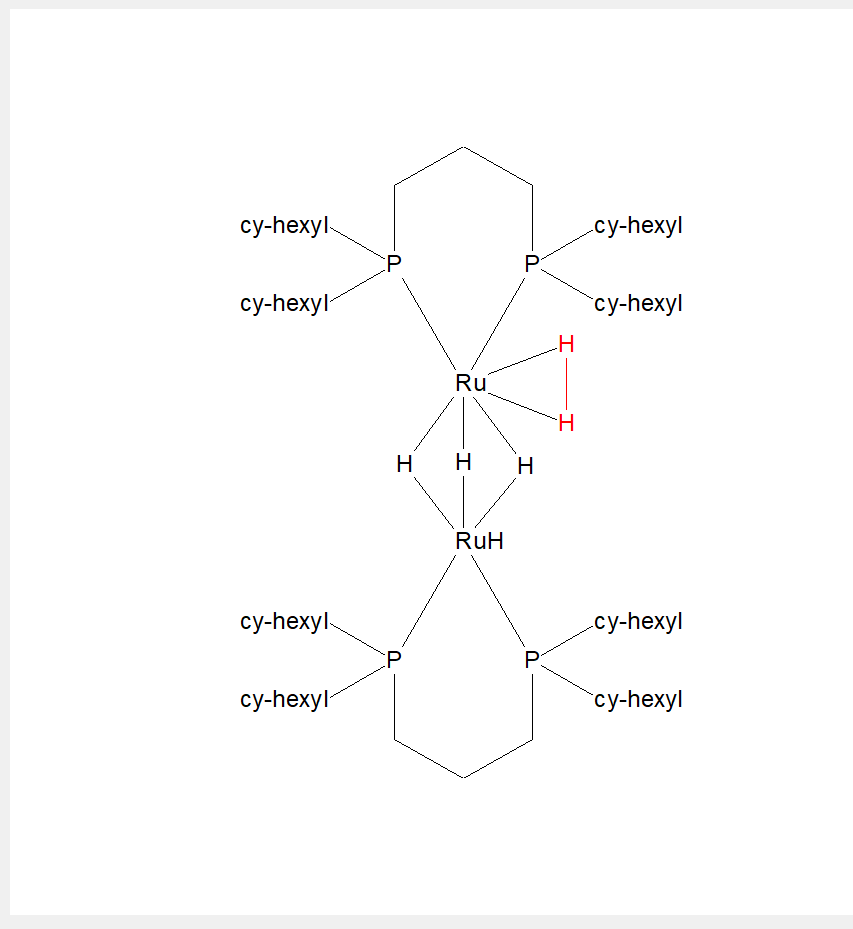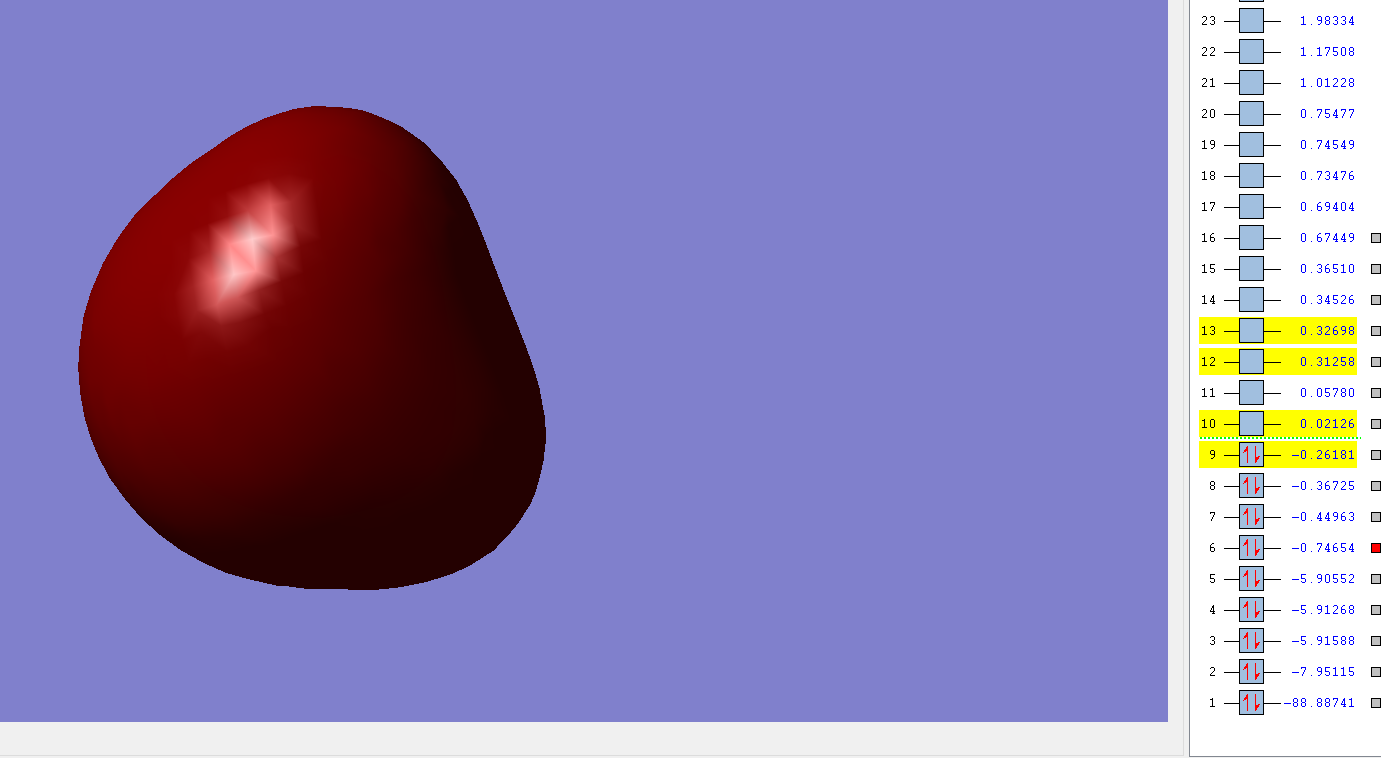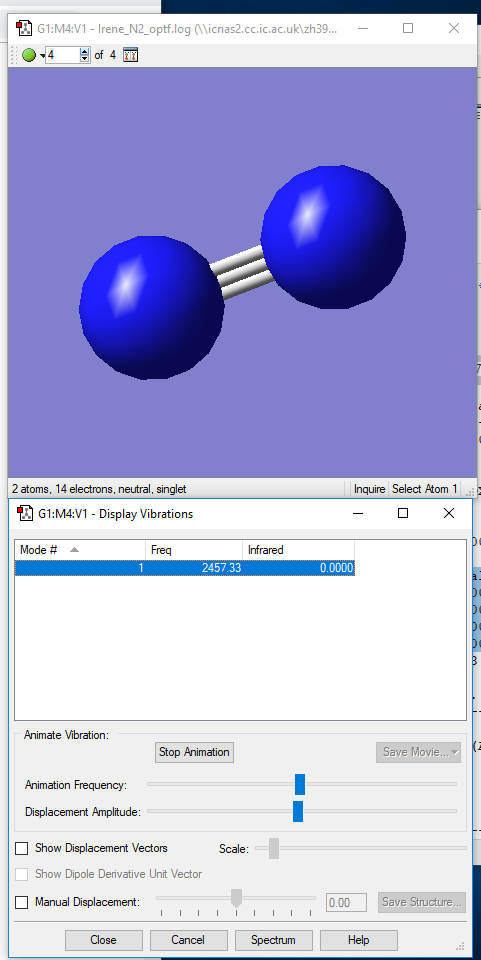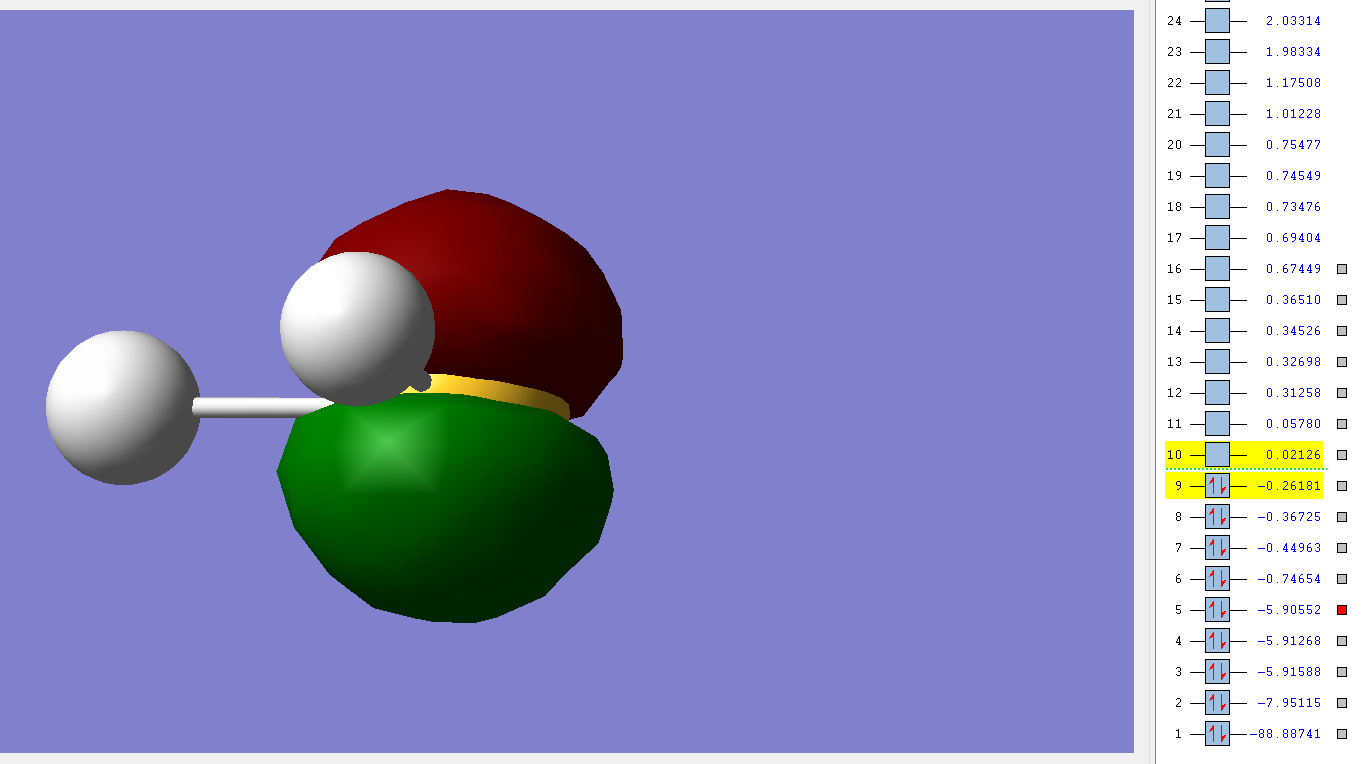Rep:Mod:ZHF3918
Molecule: NH3;
Calculation method: RB3LYP;
Basis set: 6-31G(d,p);
Final energy E(RB3LYP): -56.44397188 a.u.;
RMS gradient: 0.05399560 a.u.;
Point group: C3V;
Optimised N-H bond distance: 1.018Å
;
Optimised H-N-H bond angle: 106°
<pre>
Item Value Threshold Converged? Maximum Force 0.000004 0.000450 YES RMS Force 0.000004 0.000300 YES Maximum Displacement 0.000072 0.001800 YES RMS Displacement 0.000035 0.001200 YES
test molecule |
The optimisation file is liked to here
| vabration | wavenumber/cm-1 | symmetry | intensity |
|---|---|---|---|
| 1 | 1090 | A1 | 145 |
| 2 | 1694 | E | 14 |
| 3 | 1694 | E | 14 |
| 4 | 3461 | A1 | 1 |
| 5 | 3590 | E | 0 |
| 6 | 3590 | E | 0 |
- how many modes do you expect from the 3N-6 rule? A: 6 modes.
- which modes are degenerate (ie have the same energy)? A: 2 and 3, 5 and 6.
- which modes are "bending" vibrations and which are "bond stretch" vibrations? A: 1, 2,3 are bending vibrations, 4, 5, 6 are bond stretch vibrations.
- which mode is highly symmetric? A: 1,4 are highly symmetric.
- one mode is known as the "umbrella" mode, which one is this? A: 1 is known as the "umbrella" mode.
- how many bands would you expect to see in an experimental spectrum of gaseous ammonia? A: 4.
The charge on N-atom is -1.125, and the charge on H-atoms are 0.375. I would expect the charge on N-atom to be negative and the charge on H-atom to be positive, since nitrogen is more electronegative than hydrogen, the electrons in the bonds tend to be closer to the N-atom.
| molecule | N2 |
|---|---|
| Calculation Method | RB3LYP |
| Basis Set | 6-31G(d,p) |
| Final energy E(RB3LYP) | -109.52359111 a.u. |
| RMS Gradient | 0.02473091 a.u. |
| Point Group | D*H |
| Optimised bond length | 1.09Å |
Item Value Threshold Converged? Maximum Force 0.000001 0.000450 YES RMS Force 0.000001 0.000300 YES Maximum Displacement 0.000000 0.001800 YES RMS Displacement 0.000000 0.001200 YES
test molecule |
NBO charges: 0
| vibration | wavenumber/cm-1 | symmetry | intensity |
|---|---|---|---|
| 1 | 2457 | SGG | 0 |
| molecule | H2 |
|---|---|
| Calculation Method | RB3LYP |
| Basis Set | 6-31G(d,p) |
| Final energy E(RB3LYP) | -1.15928020 a.u. |
| RMS Gradient | 0.09719500 a.u. |
| Point Group | D*H |
| Optimised bond length | 0.600Å |
Item Value Threshold Converged? Maximum Force 0.000000 0.000450 YES RMS Force 0.000000 0.000300 YES Maximum Displacement 0.000000 0.001800 YES RMS Displacement 0.000001 0.001200 YES
test molecule |
| vibration | wavenumber/cm-1 | symmetry | intensity |
|---|---|---|---|
| 1 | 4466 | SGG | 0 |
The mono-metallic TM complex that coordinates H2 has a unique identifier REYMIS,
E(NH3)=-56.41397188 a.u.
2*E(NH3)=-112.82794376 a.u.
E(N2)=-109.52359111 a.u.
E(H2)=-1.15928020 a.u.
3*E(H2)=-3.4778406 a.u.
ΔE=2*E(NH3)-[E(N2)+3*E(H2)]=0.17348795 a.u.= 0.17349 a.u.=455.5 kJ/mol
Gaseous reactants are more stable.
molecule SH2 Calculation Method RB3LYP Basis Set 6-31G(d,p) Final Energy E(RB3LYP) -399.39162414 a.u. RMS Gradient 0.00012068 a.u. Point Group C2V Optimised S-H bond loength 1.35Å Optimised H-S-H bonf angle 93°
Item Value Threshold Converged?
Maximum Force 0.000175 0.000450 YES
RMS Force 0.000145 0.000300 YES
Maximum Displacement 0.000386 0.001800 YES
RMS Displacement 0.000386 0.001200 YES
test molecule |
The optimisation file is liked to here
vibration wavenumber/cm-1 symmetry intensity 1 1224 A1 5 2 2692 A1 7 3 2712 B2 9
The charge on the S-atom is -0.164, the charges on the H-atoms are 0.082.
These MOs are contributed by 2p orbitals in the S-atom, are non-bonding orbitals, are high in energy. These 3 MOs are occupied by 2p electrons.
 This MO is contributed by 3p orbitals in the S-atom, occupied by 3p electrons, and this is a non-bonding orbital, high in energy.
This MO is contributed by 3p orbitals in the S-atom, occupied by 3p electrons, and this is a non-bonding orbital, high in energy.
 This MO is contributed by 3s orbitals in the S-atom overlapping s orbitals in the two H-atoms. This MO is bonding in the LUMO region. The S-H bonding is strong.
This MO is contributed by 3s orbitals in the S-atom overlapping s orbitals in the two H-atoms. This MO is bonding in the LUMO region. The S-H bonding is strong.
Marking
Note: All grades and comments are provisional and subject to change until your grades are officially returned via blackboard. Please do not contact anyone about anything to do with the marking of this lab until you have recieved your grade from blackboard.
Wiki structure and presentation 0/1
Is your wiki page clear and easy to follow, with consistent formatting? Do you effectively use tables, figures and subheadings to communicate your work?
Your wiki is a bit scrambled with no subheadings. The captions for your jmols are "test molecule" instead of ammonia etc. You should not use screenshots including your entire desktop in a lab report!
NH3 0.5/1
Have you completed the calculation and given a link to the file?
YES
Have you included summary and item tables in your wiki?
YES
Have you included a 3d jmol file or an image of the finished structure?
YES
Have you included the bond lengths and angles asked for?
YES
Have you included the “display vibrations” table?
YES
Have you added a table to your wiki listing the wavenumber and intensity of each vibration?
YES
Did you do the optional extra of adding images of the vibrations?
YES
Have you included answers to the questions about vibrations and charges in the lab script?
YES - good explanation of the charges and most of the vibration questions were answered correctly.
However due to the low intensity of vibrations 4, 5 and 6 you only see two peaks in the IR spectrum.
N2 and H2 0.5/0.5
Have you completed the calculations and included all relevant information? (summary, item table, structural information, jmol image, vibrations and charges)
YES
Crystal structure comparison 0/0.5
Have you included a link to a structure from the CCDC that includes a coordinated N2 or H2 molecule?
There is no link.
Have you compared your optimised bond distance to the crystal structure bond distance?
You have not compared the bond distances.
Haber-Bosch reaction energy calculation 0/1
Have you correctly calculated the energies asked for? ΔE=2*E(NH3)-[E(N2)+3*E(H2)]
No
Have you reported your answers to the correct number of decimal places?
YES
Do your energies have the correct +/- sign? No
Have you answered the question, Identify which is more stable the gaseous reactants or the ammonia product?
YES, but incorrectly - actually the product is more stable.
Your choice of small molecule 2.5/5
Have you completed the calculation and included all relevant information?
YES
Have you added information about MOs and charges on atoms?
YES - you have included some relevant information. You could have described the MOs in much more detail and explained the charges on the atoms in terms of electronegativity.
Independence 0/1
If you have finished everything else and have spare time in the lab you could: Check one of your results against the literature, or Do an extra calculation on another small molecule, or Do some deeper analysis on your results so far
No independent work.






